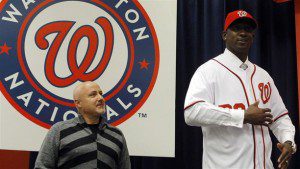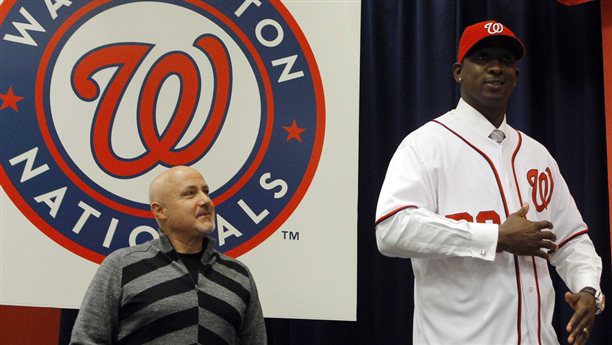

Spring training seems to have lasted forever this year, but as the Washington Nationals head north to face the New York Yankees in their final exhibition game today, they haven’t done anything to chance the widely held view that they are once again the team to beat in the National League.
A lot has already been written about the additions made to the line-up over the summer, so I won’t rehearse that here. What I haven’t read much about is whether those additions actually make them better, and what the Washington Nationals need to do to fend off the Braves to retain the National League East.
The two additions to the everyday line-up saw Denard Span come over from the Minnesota Twins and former Brave Rafael Soriano becoming the new closer. On the surface, they might look like good moves, but the extent to which they make the club better is a matter of debate.
Span is slated to be the lead-off guy this season having previously done so for the Twins. Last year he had an OBP of .342, which would have ranked him forth among eligible players on the Washington Nationals, who were led by Jason Werth with .387, admittedly only in 81 games. Span has failed to live up to his career OBP of .357 for the last three years, during which time he have chalked up an unimpressive .334. Over the same time frame Werth has an OBP of .367, five points above his career mark. Part of the problem for Span is he doesn’t take enough walks, only once every 11.8 PAs in the last three years, compared to Werth’s impressive rate of a walk every 8.8 PAs.
The more comprehensive stat of OPS also gives Werth the edge. Last year he recorded .827, while Span could manage just .738, something bettered by six of the everyday Washington Nationals. As Werth missed half the season, it bares noting that Span has an OPS of just .701 while Werth stands at .826 over the past three years. Slugging might not seem to be important in a lead-off guy, but there will be plenty of occasions when he will inherit a runner at second following a sacrifice by the pitcher, something Span has not yet had to contend with in the American League.
The addition of Soriano is harder to argue with. I don’t pay much attention to the lingering psychological effects on players, but every time Drew Storen takes the ball in the ninth inning, everyone will at least be thinking about that game five horror show. The ability to move him to the eighth inning alongside Tyler Clippard strengthens an already impressive bullpen. Soriano would have been worthy of the closer spot in his own right after a 2012 which saw him record 42 saves and a WHIP of 1.16. It will be worth watching his walk and hits per nine innings though, both of which were higher than the Nats team average last year.
So, what else do the Washington Nationals need to do this year to repeat their 2012 run? Well, the first thing is try and keep everyone healthy. The starting position players only averaged 131 games last year, with only Adam LaRoche and Danny Espinosa missing fewer than 20. While Werth appears to have fully recovered from his wrist injury, all eyes will be on Ryan Zimmerman to see how his shoulder holds up after surgery in the winter.
Run production was also an issue last year, as more than five runs were plated on only 52 occassions, seven of which resulted in losses. The games missed by Werth and Zimmerman may account for some of that though, and Bryce Harper looks set to have a massive season which could make his Rookie of the Year performance look like a gentle warm-up.
None of what I’ve written takes away from the fact this is a good team that should win over 90 games again this year. But with the Braves looking better than last year when they ran the Washington Nationals down to the wire, it remains to be seen whether “good” will be enough to get it done in the NL East this year.

